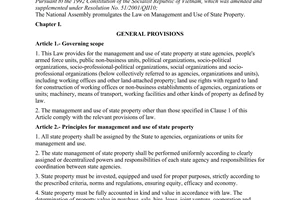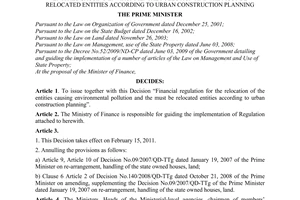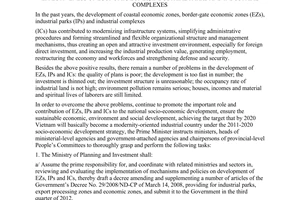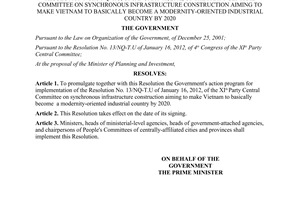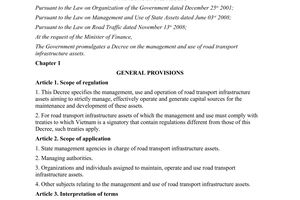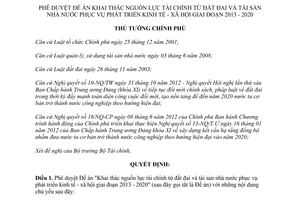Nội dung toàn văn Decision No. 2174/QD-TTg 2013 exploitation of financial for socio-economic development 2013 2020
|
THE PRIME
MINISTER |
SOCIALIST
REPUBLIC OF VIETNAM |
|
No. 2174/QD-TTg |
Hanoi, November 12, 2013 |
DECISION
APPROVING THE SCHEME ON EXPLOITATION OF FINANCIAL RESOURCES FROM LAND AND STATE ASSETS FOR SOCIO-ECONOMIC DEVELOPMENT DURING 2013-2020
THE PRIME MINISTER
Pursuant to the December 25, 2001 Law on Organization of the Government;
Pursuant to the June 3, 2008 Law on Management and Use of State Assets;
Pursuant to the November 26, 2003 Land Law;
Pursuant to Resolution No. 19-NQ/TW of October 31, 2012, of the sixth plenum of the Party Central Committee (XIth Congress), on continued renewal of land policies and law in the period of accelerated comprehensive renewal to create a foundation for our country to basically become a modernity-orientated industrial country by 2020;
Pursuant to the Government’s Resolution No. 16/NQ-CP of June 8, 2012, promulgating the Government’s Plan of Action to implement Resolution No. 13-NQ/T.U of January 16, 2012, of the Party Central Committee of the XIth Congress, on building synchronous infrastructure facilities to make our country basically a modernity-orientated industrial country by 2020;
At the proposal of the Minister of Finance,
DECIDES:
Article 1. To approve the Scheme on exploitation of financial resources from land and state assets for socio-economic development during 2013-2020 (below referred to as the Scheme), with the following principal contents:
I. VIEWPOINTS, OBJECTIVES
1. Viewpoints
- Land and state assets are regarded as important financial resources for national socioeconomic development and ensuring social security assurance.
- Exploitation of financial resources from land and state assets must conform with land use master plans and plans and construction master plans; ensure immediate as well as long-term interests; economy and efficiency; and harmony between the interests of the State and related parties.
- The policy on exploitation of financial resources from land and state assets must adhere to the state-regulated market principles, ensuring publicity, transparency and sustainable development.
2. Objectives
a/ Land finance
To renew and improve land-related financial policies with the State proactively regulating market land prices by means of supply-demand relation; to ensure land pricing on the state-regulated market principles. During 2011-2020, total state budget revenues from land are forecast to reach VND 700 trillion, with an annual average of VND 70 trillion;
b/ Exploitation of financial resources from state assets
- To strive to complete by 2018 the rearrangement and handling of state-owned land and houses nationwide (including also land and houses of state groups and corporations). The proceeds from the sale of land-attached assets and transfer of land use rights with regard to redundant houses and land, in the forms of auction and handling of land and houses associated with the restructuring of economic groups and state corporations, are forecast to reach about VND 100 trillion;
- To strive to complete by 2020 the relocation of polluting establishments and establishments to be relocated under approved planning. The proceeds from the change of land use purposes according to land use master plans and plans, and sale or transfer of (old) houses and land are forecast to reach some VND 18 trillion.
c/ Exploitation of financial resources from infrastructure assets
- To mobilize and effectively use capital sources for development of transport infrastructure. To attract capital from the private sector for building and commercially operating transport infrastructure, thereby reducing state budget expenditures by an annual average of some VND 42 trillion;
- To pilot the lease of the right to commercially operate, or transfer for a definite term of, some types of transport infrastructure assets such as railways, seaports and airports;
- To reasonably regulate added value from land not arising from land users’ investment. For the immediate future, to improve mechanisms and regulations and thoroughly implement the method of exploiting land strips along newly built roads in accordance with the land law and other relevant laws. The proceeds from the exploitation of roadside land strips are forecast to reach some VND 10 trillion a year up to 2020.
II. MAJOR SOLUTIONS OF THE SCHEME
1. Group of land-related financial solutions
a/ To continue renewing land-related financial policies in the direction that the State shall proactively regulate land prices on the market by means of supply-demand relation; to ensure land pricing on the state-regulated market principles.
b/ To step up recovery of land according to land use master plans and plans in order to create clean land funds for land use rights auction. To continue reviewing and renewing regulations concerning the auction of land-occupying projects along the line of minimizing the designated allocation or lease of land;
c/ To study and propose the application of the only form of land lease by the State with annual rent payments or lump-sum rent payments for the whole lease term for production and business land areas, to all entities, domestic and foreign, and all economic sectors;
d/ To narrow the group of subjects eligible for land allocation without land use levy collection. To improve the policy on collection of rents for underground space used for building underground works for production and business purposes;
dd/ When building urban infrastructure facilities and embellishing urban centers, it is a must to plan and organize exploitation of roadside land strips and adjacent areas in order to create resources from land for investment in these works. At the same time, to study mechanisms for appropriate compensation and ground clearance when expanding the scope of land recovered for building transport infrastructure.
e/ To study and formulate a policy to reasonably regulate added value from land not arising from land users’ investment, for the immediate future, added value from the State’s investment in building infrastructure and embellishing urban centers;
g/ To review all policies on land use levy and land rent exemption and reduction to ensure synchrony between land-related financial policies and investment and tax laws; to restrict cases eligible for exemption and reduction; to study and formulate a policy on substantial change from reduction and exemption incentives to direct grant to beneficiaries in order to enhance control and raise policy effectiveness;
h/ To scrutinize the system of policies on taxes, charges and fees related to land administration and use. To take the initiative in studying and submitting to the National Assembly a Law on Asset Tax governing taxable objects being both land and land-attached assets. To study and impose a heavier tax on abandoned land, and allocated or leased land that fails to be put into use on schedule;
i/ To review policies on real estate market management; to study and propose coordinated application of measures to promote the sound development of the real estate market: (i) applying non-cash payments in real estate transactions; allocating and leasing land in a public and transparent manner; (ii) increasing management and control of the real estate market; raising the role and responsibility of central state management agencies in the inspection and appraisal of investment and bank loans for housing development and real estate projects in order to ensure that investors are capable of implementing the projects; (iii) restructuring real estate commodities in conformity with market demands while stepping up development of types of social houses with the State’s participation and regulation to meet housing needs of people facing housing difficulties, thus contributing to economic development and social security assurance;
k/ To review regulations on land pricing; to study and propose regulations on land pricing to enhance the capacity and operation of the land pricing system and financial support instruments; to proceed to professionalizing compensation and clearance work in order to speed up ground clearance to create clean land areas for auction of land allocation or lease;
l/ To step up reform of land-related administrative procedures, with a focus on removing problems in the organization of implementation, especially in the land allocation and lease, auction of land use rights, land pricing, land-related financial obligations, and compensation, support and resettlement upon land recovery by the State;
m/ To review land use management work, paying attention to cases in which allocated or leased land is not put into use or is used inefficiently or behind schedule, causing land waste and fallowing, and taking measures to quickly put such land into use. Allocated land which cannot be put into use must be used for more effective purposes, especially land in industrial parks, export processing zones or economic zones under the Prime Minister’s Directive No. 07/CT-TTg of March 2, 2013; to propose regulations to resolutely recover allocated land which has been used wastefully or improperly in contravention of the land law; to propose specific plans for effective exploitation and use of recovered land. Besides sanctions against the cases of delayed exploitation and use of land, it is necessary to introduce incentives to encourage organizations and individuals to expeditiously put their allocated land into use, thus bringing about socio-economic benefits.
2. Group of solutions on exploitation of financial resources from state assets
a/ To clearly determine the lights and responsibilities in the management and use of assets between state agencies and public non-business units, specifically:
- For state agencies, to invest, build and arrange according to prescribed standards and norms, monitor, update and adjust in conformity with actual changes in the use demand for, state assets, financial capacity and economic development of the country, proceeding to forming concentrated administrative quarters.
- For public non-business units, to renew the operation mechanism according to the Political Bureau’s Conclusion No. 37/TB-TW of May 26, 2011, which states that for public non-business units that can self-finance their operations like businesses, there will be a roadmap for them to shift from the mechanism of land allocation without land use levy collection to land lease in order to create proactiveness and transparency in the cost-accounting of public services, and gradually reduce state subsidies while still ensuring the stability and development of these units;
b/ To step up the rearrangement and handling of state-owned land and houses with regard to polluting establishments or those to be relocated under planning; to intensify coordination among ministries, sectors and localities, ensuring early completion and announcement of relevant master plans for implementation; to create housing and land funds for arrangement and use under local planning. At the same time, to study, amend and supplement relevant regulations and laws to create momentums and incentives for those that are subject to arrangement and relocation and ensure harmony of interests of related parties in the course of implementation;
c/ To rearrange and handle houses and land in the process of restructuring state economic groups and corporations on the following principles:
- Fully grasping existing housing and land funds currently managed and used by the state groups and corporations (including also their member companies), as a basis for rearranging the land funds in conformity with their tasks and fields of operation, with a focus on industrial parks, economic zones and trade zones;
- Selling housing and land funds that are redundant after rearrangement and handling to support or create investment capital for production and business under decisions of competent authorities and laws;
- Withdrawing, auctioning or transferring to localities for use for public interests under planning redundant housing and land funds for which the enterprises have no plans for rational and effective use;
- Assessing the land use demand and effectiveness of equitized enterprises, then applying financial and economic measures to promote the effective use of land; organizing relocation of polluting production and business establishments and labor-intensive ones out of urban areas. When implementing equitization plans, it is a must to value state assets according to market principles, including land use rights;
- Collecting land use levies and land rents according to the new mechanism, ensuring land prices close to market reality; at the same time intensifying control of capital use by state groups and corporations, restricting investments that are not related to the enterprises’ main tasks, gradually converting and withdrawing capital from real estate business (applicable to state enterprises not engaged in real estate investment, construction and trading);
d/ To step up the review, measurement and determination of boundaries, placement of markers, compilation of cadastral dossiers, and handling of existing land areas currently managed and used by state-owned agricultural and forestry farms, including recovering land areas that are being used ineffectively or improperly, for auction of land use rights or bidding of land-occupying projects;
dd/ To step up the sale of state-owned houses to current tenants, or renovating, upgrading and further leasing these houses at cost-offsetting rent rates if their current tenants do not want to buy them.
3. Group of solutions on exploitation of financial resources from infrastructure assets
a/ To strongly attract and effectively use investment capital sources for transport infrastructure development through socialization and expansion of investment methods; to raise the quality of use of investment capital for transport infrastructure development;
b/ To implement mechanisms with a view to further exploiting financial resources from transport infrastructure, thereby raising capital for developing transport infrastructure (seaports, airports and railways, etc.) through lease of the right to commercial operation or transfer for a definite term;
c/ To renew the mechanism of maintenance of transport infrastructure assets in the direction of:
- Applying a new mechanism with a sole focal point in the state budget management of investment capital for new construction and capital for maintenance of transport infrastructure assets, and in the assignment of the maintenance responsibility for these assets to their construction contractors with a view to raising construction quality and reducing maintenance costs;
- Balancing expenditures for the construction of transport infrastructure and for the maintenance of infrastructure works, giving priority to maintenance work in order to ensure the useful life and quality of these works;
- Renewing the transport infrastructure maintenance work by applying the method of contracted maintenance in replacement of the method of maintenance for which payment is made based on actually performed work. This mechanism helps reducing payment and settlement workload while promoting the initiative of maintenance contractors in ensuring the technical conditions of transport infrastructure.
d/ Along with collecting road toll, to step up the implementation of the Government’s Decree No. 10/2013/ND-CP of January 11, 2013, on management, use and exploitation of road infrastructure assets.
III. ORGANIZATION OF IMPLEMENTATION
1. The Ministry of Finance shall assume the prime responsibility for, and coordinate with related ministries and sectors in:
a/ Regarding exploitation of financial resources from land
- Formulating and submitting to the Government for promulgation decrees guiding a number of articles of the Land Law (amended) after it is passed by the National Assembly, which fall within the scope of functions and tasks of the Ministry of Finance as assigned by the Government;
- Taking the initiative in studying and submitting to the National Assembly for promulgation the Law on Asset Tax at an appropriate time, regulating taxable objects being both land and land-attached assets, from 2015;
- Studying and submitting to the Prime Minister for promulgation a pilot mechanism allowing households to contribute their rights to use agricultural land as capital shares to production, business or service projects for implementation under the land use master plan in 2013;
- Studying and submitting to the Prime Minister for promulgation in 2014 regulations on land-related financial obligations of build-transfer (BT) investment projects;
- Studying, formulating and submitting to the Prime Minister for promulgation in 2015 a mechanism to regulate added value from land not arising from land users’ investment;
- Studying and guiding in 2015 the contribution as joint-venture or partnership capital of the value of land use rights of self- financing public non-business units.
b/ Regarding exploitation of financial resources from state assets
- Reviewing and assessing, and proposing amendments and supplements to, the Law on Management and Use of State Assets in 2014;
- Reporting to the Prime Minister on results of implementation of Decision No. 09/2007/QD-TTg of January 19,2007, on rearrangement and handling of state-owned houses and land, and Decision No. 86/2010/QD-TTg of December 22, 2010, on financial regulations applicable to the relocation of polluting establishments and establishments to be relocated under urban construction planning, and amended and supplemented orientations, with a view to accelerating implementation in 2014;
- Studying, formulating and promulgating to the Prime Minister for promulgation a decision on arrangement of houses and land of state economic groups and corporations (including also equitized enterprises and public non-business units that have shifted to operate like enterprises) in 2014.
c/ Regarding exploitation of resources from infrastructure assets
- Promulgating documents guiding the implementation of the Government’s Decree No. 10/2013/ND-CP of January 11, 2013, on management, use and exploitation of road transport infrastructure assets according to its assigned functions and tasks.
- Studying, formulating and submitting to the Government for promulgation decrees on the management, use and exploitation of transport infrastructure assets in each field: railway, inland waterway, seaway and airway, in 2014 and 2015.
2. The Ministry of Natural Resources and Environment shall assume the prime responsibility for, and coordinate with related ministries and sectors in, formulating and submitting to the Government for promulgation decrees guiding a number of articles of the Land Law (amended) after its is passed by the National Assembly within the scope of the functions and tasks of the Ministry as assigned by the Government.
3. The Ministry of Justice shall assume the prime responsibility for, and coordinate with related ministries and sectors in, studying, formulating and submitting to the Prime Minister for approval a scheme on development of the auction profession, auction practicing organizations, and enhancement of professional management and state management in the field of asset auction, in 2016.
4. The Ministry of Construction shall assume the prime responsibility for, and coordinate with related ministries and sectors in, reviewing policies on management of the real estate market, studying and proposing the coordinated application of measures to promote the sound development of the real estate market.
5. Ministries, sectors and localities
Ministries, ministerial-level agencies, government-attached agencies, central bodies of mass organizations, and provincial-level People’s Committees shall coordinate with the above ministries in organizing, inspecting, examining and supervising the implementation of this Scheme according to their assigned functions, tasks and powers.
Article 2. This Decision takes effect on the date of its signing.
Article 3. Ministers, heads of ministerial-level agencies, heads of government-attached agencies, and chairpersons of provincial-level People’s Committees shall implement this Decision.-
|
|
PRIME MINISTER |


